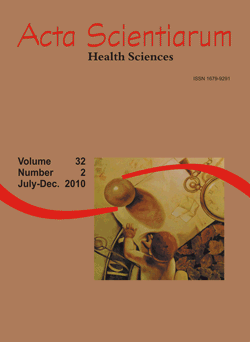<b>Air quality and number of hospital admissions for respiratory disease among children in the city of Divinópolis, Brazil</b> - doi: 10.4025/actascihealthsci.v32i2.7344
Keywords:
respiratory tract diseases, air pollution, air quality, particulate matter
Abstract
Respiratory problems represent one of the main morbidity causes in children in practically all of Brazil, with air pollution being one of the chief causes. This work was intended to evaluate the association between the number of hospital admissions for respiratory problems in children and the concentration of suspended particulate material in suspension in the town of Divinópolis, Minas Gerais State, in the period from 2000 to 2006. The methodology used was that of the descriptive and exploratory non-experimental research, characterizing itself in a retrospective study. It was found that during the investigated period, respiratory disturbances reached the top position in hospitalizations in public hospitals, corresponding to the main cause of admission and representing one third of all admissions over that period. The analysis of the data stressed an inverse ratio between the concentration of particulates in air and meteorological change. The data show further that there is a direct relationship between the concentration of particulates in the atmosphere, air quality and the epidemiologic picture, the latter pictured by the number of hospital admissions of children for respiratory diseases.Downloads
Download data is not yet available.
Published
2010-09-28
How to Cite
Bueno, F. F., Fonseca, A. R., Braga, F. A., & Miranda, P. S. C. (2010). <b>Air quality and number of hospital admissions for respiratory disease among children in the city of Divinópolis, Brazil</b> - doi: 10.4025/actascihealthsci.v32i2.7344. Acta Scientiarum. Health Sciences, 32(2), 185-189. https://doi.org/10.4025/actascihealthsci.v32i2.7344
Issue
Section
Medicine
DECLARATION OF ORIGINALITY AND COPYRIGHTS
I Declare that current article is original and has not been submitted for publication, in part or in whole, to any other national or international journal.
The copyrights belong exclusively to the authors. Published content is licensed under Creative Commons Attribution 4.0 (CC BY 4.0) guidelines, which allows sharing (copy and distribution of the material in any medium or format) and adaptation (remix, transform, and build upon the material) for any purpose, even commercially, under the terms of attribution.
Read this link for further information on how to use CC BY 4.0 properly.























5.png)







